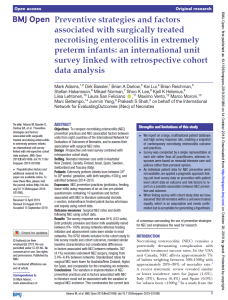
Objectives
To compare necrotizing enterocolitis (NEC) prevention practices and NEC associated factors between units from eight countries of the International Network for Evaluation of Outcomes of Neonates, and to assess their association with surgical NEC rates.
Design
Prospective unit-level survey combined with retrospective cohort study.
Setting
Neonatal intensive care units in Australia/New Zealand, Canada, Finland, Israel, Spain, Sweden, Switzerland and Tuscany (Italy).
Patients
Extremely preterm infants born between 240 to 286 weeks’ gestation, with birth weights<1500 g, and admitted between 2014–2015.
Exposures
NEC prevention practices (probiotics, feeding, donor milk) using responses of an on-line pre-piloted questionnaire containing 10 questions and factors associated with NEC in literature (antenatal steroids, C-section, indomethacin treated patent ductus arteriosus and sepsis) using cohort data.
Outcome measures
Surgical NEC rates and death following NEC using cohort data.
Results
The survey response rate was 91% (153 units). Both probiotic provision and donor milk availability varied between 0%–100% among networks whereas feeding initiation and advancement rates were similar in most networks. The 9792 infants included in the cohort study to link survey results and cohort outcomes, revealed similar baseline characteristics but considerable differences in factors associated with NEC between networks. 397 (4.1%) neonates underwent NEC surgery, ranging from 2.4%–8.4% between networks. Standardised ratios for surgical NEC were lower for Australia/New Zealand, higher for Spain, and comparable for the remaining six networks.
Conclusions
The variation in implementation of NEC prevention practices and in factors associated with NEC in literature could not be associated with the variation in surgical NEC incidence. This corroborates the current lack of consensus surrounding the use of preventive strategies for NEC and emphasises the need for research.